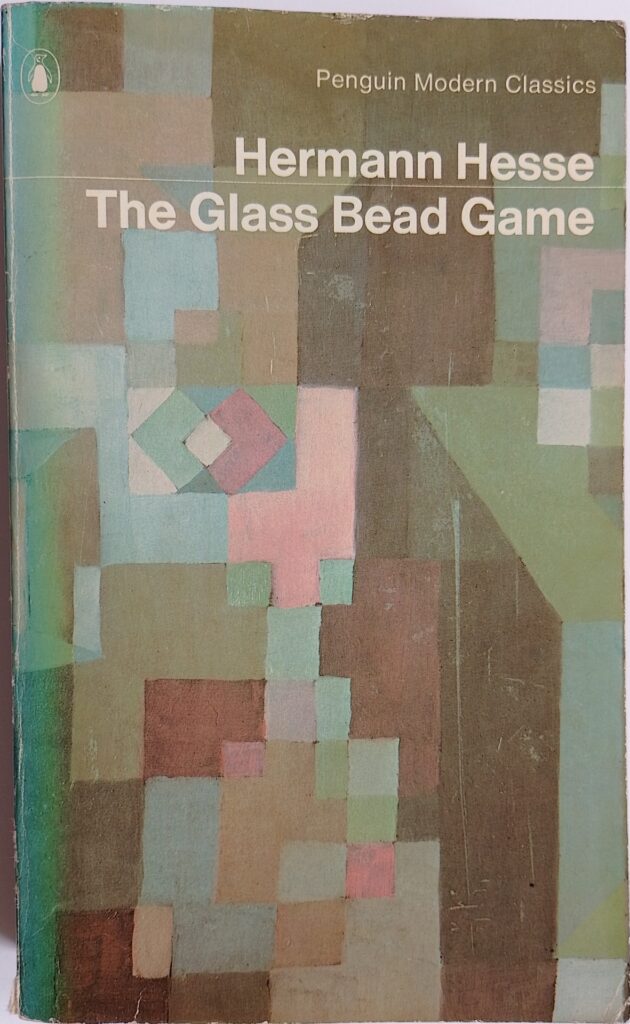First published 1943. Penguin, paperback, 1979, translated by Richard and Clara Winston, 1960, pp 519, c.190,000 words.
I first read this long ago, and it made a big impression on me, so I was greatly looking forward to rereading it. The back cover says ‘This is Hermann Hesse’s great novel.’
The book is written as a biography of Joseph Knecht, who rises to become one of the great leaders of the quasi-monastic order of aesthetes who are the keepers of scholastic traditions in mathematics, music, language and similar, as well as the titular game, which centres around a synthesis of these subjects. As the order frowns on the cult of personality, records are apparently sparse. This structure is one of the flaws of the book because it comes across in the same way as a Livy history: it’s more about style than historic accuracy. Conversations are often given in detail for which there is often no explanation. Occasionally they are said to have been taken from correspondence, which seems implausibly thin.
The time when the subject lived is given as something over two hundred and fifty years in the future. The twentieth century was the ‘age of wars’ and this was followed by an age of philistinism. It was in response to this that the order was founded, to try to recapture and develop the high arts and advanced science. It is made clear that this is not a religious order and relations with the catholic church and religious monastic orders are distant. It is a future that seems to have got stuck in the mid-twentieth century, with newspapers, a few human driven cars, lecturers who project slides onto screens, and where calculations are performed by slide-rule.
The location is somewhere like Switzerland, where Hesse spent much of his life. The state funds the order, and in return, the order trains teachers, and in the process is able to select the most able pupils to join the order, which is unashamedly elitist. It is also stuck in the past, at least as far as music is concerned; the composers mentioned are exclusively classical and drawn from the seventeenth and eighteenth centuries, and yet the game seems closer to jazz with its improvisations and developments of themes.
The order is celibate and exclusively male. The place of women in society hasn’t moved on from the nineteenth century. There are very few women mentioned at all, and those that are have minor roles and are generally stereotyped as superficial, gossipy and dangerous to men.
Hesse is aware of the flaws of the order. At a critical stage in Knecht’s development he engages in debate with a fellow pupil who is not destined to join the order. The fellow describes the order as ‘sterile and parasitical’. I found myself rather in agreement with the outsider. Elsewhere the game is described as ‘passionless’, ‘child-like’, and ‘bloodless’.
Knecht is drawn as the perfect corporate man: admired by those both above and below him in the hierarchy, unambitious yet rising rapidly through the ranks. He expresses the desire to be free of responsibilities so that he can study whatever he likes, but he has responsibility thrust upon him, eventually being elected head of the game section of the order. However, he eventually realises that he has become trapped, and the order has become fossilised, out of touch as the world around them changes. The rather abrupt ending resolves nothing.
The final fifth of the book contains some poems and three ‘lives’ that Knecht supposedly wrote as a young man. These elements didn’t add anything to what had gone before.
The translation is fluid, although it does contain a number of obscure words and some untranslated words and phrases, mostly in Latin.
This is a dry and dusty book, and consequently rather hard reading. There is no emotion in it. Characters are realistically drawn, but from a very limited set. The back cover says it ‘is a major contribution to contemporary philosophic literature’ and others must have agreed as Hesse was awarded the Nobel Prize for Literature in 1946, two years after the book’s publication .
© William John Graham, November 2022

